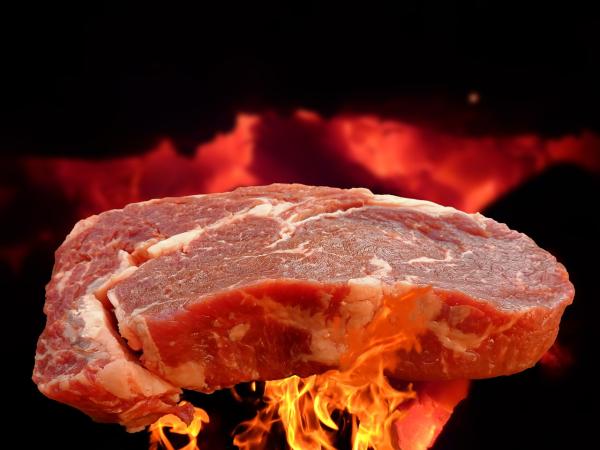“Cancer alert over rocket: Trendy salad leaves exceed safe levels of carcinogenic nitrates in one in EVERY ten samples.”
– The Daily Mail
OK, it is not a peer-reviewed headline, but it points to the confusion surrounding nitrates.
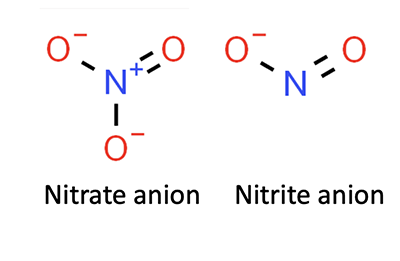 Let us begin with our heroes, the Dr. Jekyll of our tale, nitrates and nitrites. To be honest, they are the supporting actors for nitric oxide (NO), “a signaling molecule in the cardiovascular system, central nervous system (CNS), and immune system.”
Let us begin with our heroes, the Dr. Jekyll of our tale, nitrates and nitrites. To be honest, they are the supporting actors for nitric oxide (NO), “a signaling molecule in the cardiovascular system, central nervous system (CNS), and immune system.”
Originally, NO was thought to be only formed within our body – that pathway still provides about 70% of our NO. The additional 30% comes from our diet, “dietary nitrate (NO3- ) is reduced to nitrite (NO2- ) and subsequently to NO.” If something is good for you, increasing the precursor with our diet is almost as good (actually better) than a supplement. And dietary nitrates come from three sources, plants, animals, and water. But mainly, they come from your saliva. [1] Here is a graph showing typical levels of nitrates in our food.
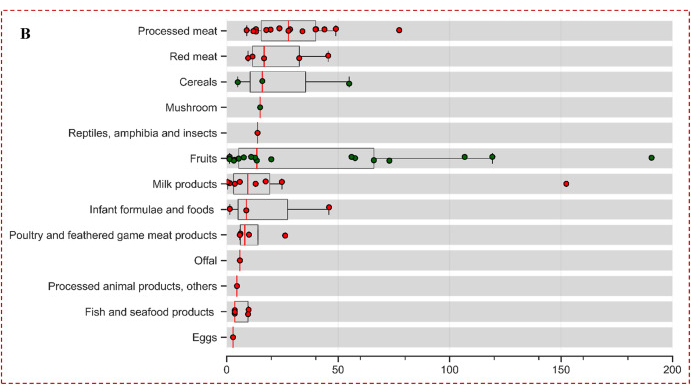
Not surprisingly for those following the mainstream narrative – at the top are “processed meats” that have acquired a bad reputation in the NO world because of nitrosamine, the Mr. Hyde of our story. (We will return there in a bit.)
Of course, as the authors of this review know (and I learned), that is not the whole story. Here are the levels for a much more extensive dietary selection.
As it turns out, leafy vegetables are the most significant dietary source of nitrates, not processed meats – but  why let facts ruin a perfect story about evil hotdogs or a grilled hamburger? The amount of nitrate in plants varies with factors including genetics, cultivation, storage, and processing. The always “out of an abundance of caution” EU has placed maximum levels of nitrates on spinach and lettuce, which average >1000 mg/kg fresh weight. Interestingly, rocket, the British term for arugula, is not regulated, although it has >2500 mg/kg fresh weight.
why let facts ruin a perfect story about evil hotdogs or a grilled hamburger? The amount of nitrate in plants varies with factors including genetics, cultivation, storage, and processing. The always “out of an abundance of caution” EU has placed maximum levels of nitrates on spinach and lettuce, which average >1000 mg/kg fresh weight. Interestingly, rocket, the British term for arugula, is not regulated, although it has >2500 mg/kg fresh weight.
Animal sources typically have little nitrate, roughly 50 mg/kg. Most animal-sourced nitrate is added as sodium and potassium nitrate, subsequently acted upon by bacteria to form nitrite and help preserve food. These levels are regulated, and in the US, there has been a shift to more “natural” sources of nitrates from plants like beetroots [2]. The EU doesn’t allow those plant sources; I guess, in this instance, synthesized nitrate is better than natural – who knew?
Finally, nitrates can come from our drinking water, often “due to drainage from soil.” A number of factors besides the nitrates of plants have doubled nitrates in the water, and it is considered a regulated contaminant. Let your heart not be troubled; the EPA is on the case allowing only 44mg/liter of nitrate – 0.42% of public water supplies have an excess. [3]
“…a growing and compelling body of evidence has developed showing that dietary nitrate improves cardiovascular function and health and lowers long-term risk of CVD.”
Most studies consider only plant-sourced nitrates, and few have considered meat or water sources. The impact on blood pressure is the most common outcome measure [4] and has “demonstrated clinically meaningful decreases in blood pressure.” For those interested in the necessary leafy green “dose,” it seems to be at ~1 cup. The meta-analysis of nitrates in meats usually does not involve processed meats but have “demonstrated no detrimental effects of red meat on cardiovascular health.” The observational studies that do involve moderate reductions in meat consumption, processed or not, are, in the authors’ words,
“limited… the link, if any, between the nitrate/nitrite content of meat and cardiovascular health outcomes is unclear.”
The role of nitrates in cognitive function has only been looked at from plant sources (it shouldn’t matter). Clinical trial data has shown benefits in some instances, no change in others. But varying doses, short treatment periods, and small numbers of participants make for little consensus.
“From a public health perspective, current epidemiological evidence suggests including one to two daily serves of nitrate-rich green leafy vegetables as part of overall vegetable intake to support/optimise muscle function.”
While an underlying mechanism remains unclear, nitrates improve muscle function and strength. NO is a well-recognized signaling molecule in modulating immune function and inflammation. Experimental studies have shown mixed results; no smoking gun exists in either direction.
– The Mr. Hyde of our Tale
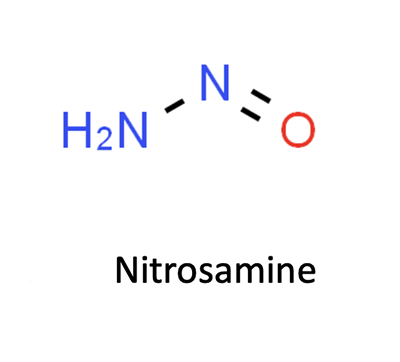 Humans are exposed to nitrosoamines, formed from nitrates and nitrites reacting with amines. They are highly carcinogenic in laboratory animals, and their presence in food is the primary concern.
Humans are exposed to nitrosoamines, formed from nitrates and nitrites reacting with amines. They are highly carcinogenic in laboratory animals, and their presence in food is the primary concern.
The formation of nitrosamines from our Dr. Jekylls is a bit circuitous.
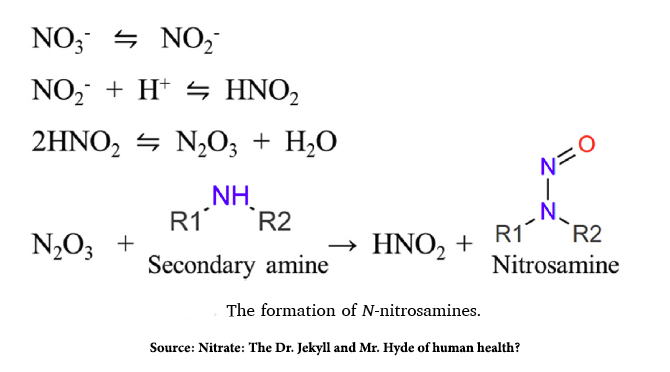
As a result, nitrosamine formation from nitrates is not 1:1; it is non-linear. The presence of any relationship has been sufficient to lead to strict regulation on their levels and use. The total amount of nitrosamine in food is roughly 10 μg/kg. Relatively high concentrations are found in nitrate and nitrite-containing meat products, but also in processed fish and, brace yourself, pickled and fermented vegetables, and here, we have to mention Kimchi.
Food and alcohol are primary sources of nitrosamines; some can also be found in drinking water. But the nitrates and nitrites of food, like Kimchi, are consumed “within the milieu of compounds contributing to the whole food matrix” – the other components of the food and the meal alter the impact of these chemicals. That may be why there seems to be an association between nitrates in processed meats and cancer but no similar association with nitrates found in water and plants. The formation of nitrosamines is influenced by the presence of other agents and the means of preparation. For example, fried bacon has nearly three-fold more nitrosamines than raw bacon. Ascorbic acid, among other chemicals, is added to cured meats to accelerate their preparation; they also retard the nitrosation reactions creating nitrosamine.
“The discovery, over 50 years ago, that nitrate has the potential to form carcinogenic N-nitrosamine compounds resulted in an assumed harm of high nitrate intakes from any source. Given the evidence of a benefit of vegetable nitrate on CVD risk, nitrate consumption from vegetables is unlikely to be problematic…Understanding the relationship of the different sources of nitrate to cancer is of critical importance because… guidelines on nitrate intake do not differentiate between dietary sources.”
What to do, you ask? Unfortunately, we must return to our mom’s advice. Eat a balanced meal, and celebrate the diversity of our food choices. Concerned about that crisp bacon? Maybe lettuce and tomato reduce the impact or consider a salad along with the BBQ. The science of a healthy, nutritional diet will not be obtained by focusing on one food or nutrient, nor will it be grasped using food frequency surveys.
[1] As is often the case, my colleague, Dr. Josh Bloom, has explored this territory previously. He points out that much of the conversion of nitrate to nitrite begins in the saliva we need to turn food into a slushy for the stomach.
[2] The high levels of nitrate in beetroots have made it an important supplement in many studies of the dietary impact of nitrates. It also explains all those ads for beets as a “superfood.”
[3] Amounts from private wells are another matter.
[4] Other outcomes include endothelial function, arterial stiffness, platelet reactivity, and aggregation.
Source: Nitrate: The Dr. Jekyll and Mr. Hyde of human health? Trends in Food Science & Technology DOI: 10.1016/j.tifs.2023.03.014
